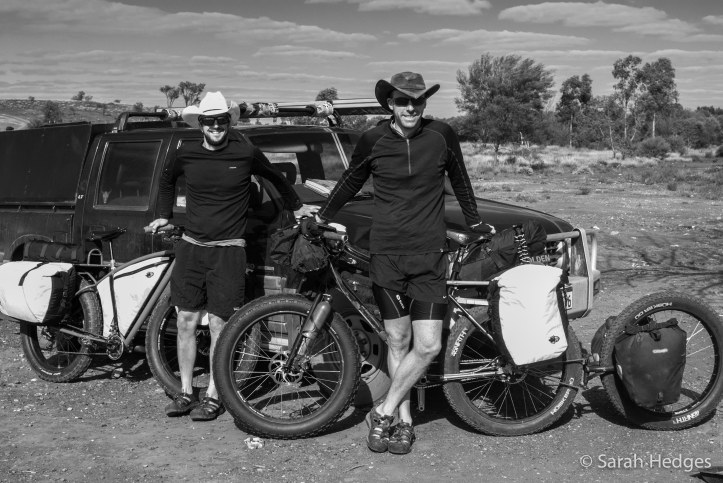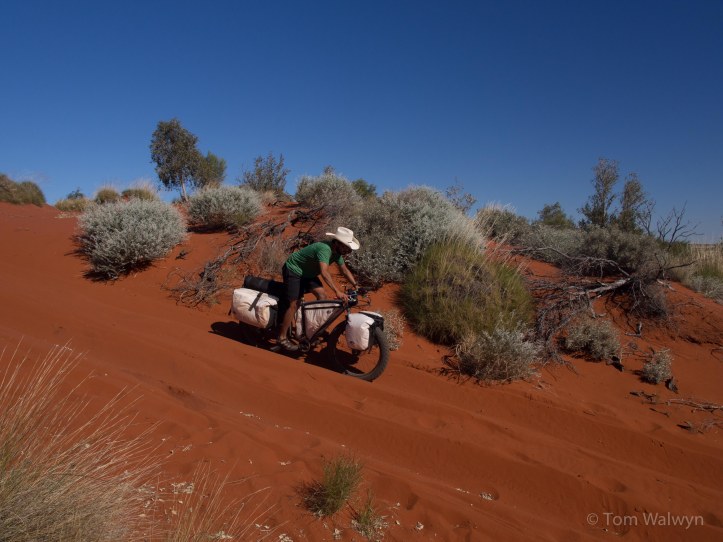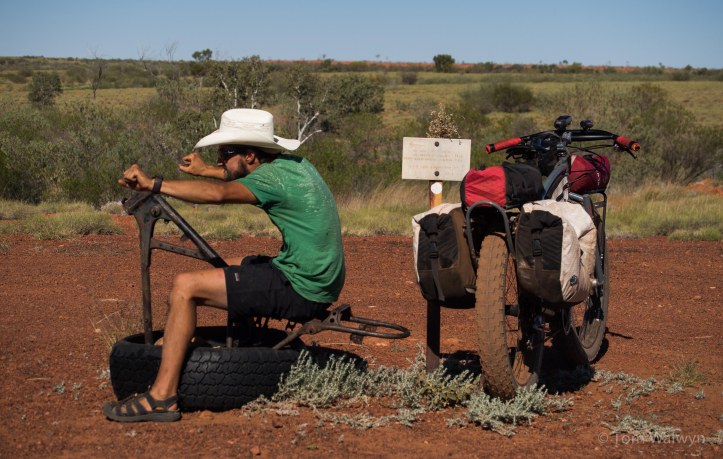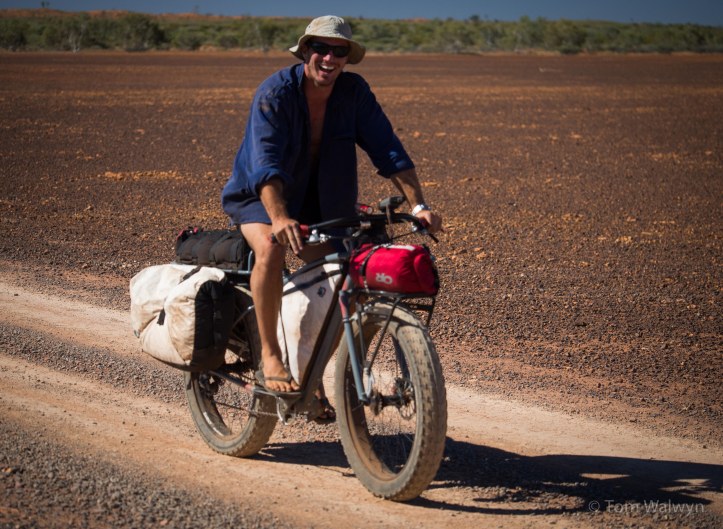Fat tyres and wide rims have made unsupported Canning Stock Route travel possible. They give ‘float’. They were originally designed for snow, but soft sand is another of the few ‘mediums’ I’ve ridden where there is a genuine possible-impossible delineation. That’s not to say that you can’t ride a more ‘normal’ mountain bike along the CSR – just that carrying the weight of food and water needed to be self-sufficient is prohibitive without super-wide tyres.
While attention to route, off-bike equipment, water sources and food demand attention, the bicycle and system for carrying all of it has to be primary to success on the CSR. In rambling order – here are a few thoughts. Scott and I used different approaches with our bicycles.
Mine was a further iteration of the (relatively) tried and tested, whereas Scott (as usual) did his own thing.  Fat Tyres/Wheels In 2005, when Jakub first rode a prototype Surly Pugsley along the CSR, there was only one ‘fat tyre’ available – the Surly Endomorph. At 26×3.7″ it was a significant step in the genre, but is no longer made. We both used ‘mid-width’ fat rims on our bicycle wheels – choosing amongst the panoply of hoops now available that range from 47mm to 100mm wide. In an effort to reduce the weight of these rims, the majority of these come with ‘windows’ through which the rim strip bulges. Understandably Scott (and others) was unwilling to take chances with rim failures, so used 82mm wide solid Surly Rolling Darryls. I went with the hole-y version (now appears to be the only one advertised on the Surly website), and didn’t suffer any problems with them. When pushed, Scott grudgingly admits that the solid rims might have been over-kill. The weight difference is equivalent to two freeze-dried meal packets per bike… I’ll mention tyre and rim issues again with regard to my trailer a little further down this post.
Fat Tyres/Wheels In 2005, when Jakub first rode a prototype Surly Pugsley along the CSR, there was only one ‘fat tyre’ available – the Surly Endomorph. At 26×3.7″ it was a significant step in the genre, but is no longer made. We both used ‘mid-width’ fat rims on our bicycle wheels – choosing amongst the panoply of hoops now available that range from 47mm to 100mm wide. In an effort to reduce the weight of these rims, the majority of these come with ‘windows’ through which the rim strip bulges. Understandably Scott (and others) was unwilling to take chances with rim failures, so used 82mm wide solid Surly Rolling Darryls. I went with the hole-y version (now appears to be the only one advertised on the Surly website), and didn’t suffer any problems with them. When pushed, Scott grudgingly admits that the solid rims might have been over-kill. The weight difference is equivalent to two freeze-dried meal packets per bike… I’ll mention tyre and rim issues again with regard to my trailer a little further down this post.

The earlier ‘fat’ cyclists didn’t really have as much choice, so used 65mm wide Large Marge rims for their bicycle wheels. The rim part of the ‘fatness’ equation contributes to a wider, flatter footprint for increased floatation in soft sand. It’s difficult to say whether the 100mm clown shoe rims would offer further advantage. Their additional width does add ‘interest’ to the chainline and gearing set-up. Tyre choice for us was dazzling – and likely to get more so, with the arrival of the ‘big players’ (Specialized and Kona etc), in contrast to the unsupported cyclists that preceeded us. Variables include width, tread pattern and casing weight. The bicycle frame used dictates the maximum rim/tyre width – meaning that I used different tyres on front (Surly Big Fat Larry, 26×4.7″) and rear (45North Hüsker Dü, 26×4.0″), whereas Scott used Big Fat Larrys for both wheels. I would say that it was worth having more ‘float’ on the front of the bike as it gave better control coming down the dunes at speed (up to 35km/hr in my case). These tyres are actually pretty thin (or they’d be even heavier), so do puncture. We both used a combination of Surly Toobs (heavy) and Specialized 26×2.7-3.0″ DH tubes (much lighter) with no noticeable difference in wear or punctures between the two. As already noted by Martijn (2011), if some latex/’goo’ can be added to the tubes, you’ll save yourself a fair amount of time as all of our punctures were thorn related. Though we’d thought to do this, neither of these tube types has a removable valve-core, rendering it impossible.

Two vs Three Wheels. Scott, aided by some Rick Hunter magic, was the first unsupported cyclist to ride the route without a trailer. It’s possible that if I didn’t already own a long wheelbase bicycle and thus hadn’t been thinking with a view to my ‘stable’ after the CSR, I would have gone in the same direction. I think I also had visions of such horrific dune pushing-fests that being able to dump the trailer weight and do a second take would have been more important. My day-mares didn’t come to pass, and I reckon that what pushing we did was easier with the drag from only two, rather than three wheels.





Precedent was on my side – Jakub, Russ and Martijn had all gone for the trailer-based approach. It’s certainly the most ‘accessible’ option as the bike can be ‘off-the-rack’. There’s still no production-model trailer that gives the sort of repair/spares flexibility that would be ideal for riding the CSR. An Extrawheel-based or -derived trailer seems to be the best out there (so far). The ‘Pugsley’ Extrawheel works with an off-set 135mm OLN rear bike (e.g. Pugsley) with a 20-22mm spacer (?provided) on the non-drive side. The production model only allows for a conventional front wheel (100mm) hub and ‘narrow’ rim with 26×4″ tyre in a symmetrical wheel build. This means that the trailer wheel ‘as is’ can only be used in the trailer, though the tyres can be swapped between wheels (26×4″ maximum – not Big Fat Larry or other 26×4.7″ tyres). I had the good fortune to have use of a prototype Extrawheel trailer built for Aga and Mateusz that took a 135mm OLN symmetrical trailer wheel. This meant that I could swap my trailer wheel with my front wheel at need; and with a bit of re-building, bodge a replacement rear wheel. The latter possibility would have meant a single gear (32T chainring/25T SS sprocket) that corresponded to the one I used most frequently on my Rohloff.




Load-carrying
Unless you’re riding with a support vehicle, you’ll have to solve the load-carrying conundrum. What you carry needs to be only what you’ll use or a limited safety-net in case of bad weather, injury or bike failure. Both Jakub and Russ used specially modified ‘as light as possible’ Crosso pannier bags, while Martijn and others used Ortlieb panniers. None used any of their frame-based carrying capacity. Both Scott and I took advantage of Scott’s ‘day job’. Using a frame-bag, bar roll and seat-pack I was able to carry all my non-food/water kit with it’s weight distribution optimised for bike-handling.



We knew from Martijn’s experience that our panniers were going to take a hammering from the close-packed vegetation along the route. All our bags, other than my trailer panniers, were made of a Dyneema-based fabric chosen for abrasion resistance and general toughness.




Drive-chain etc
“Conventional” drive chains set up to clear the wide tyres and rims used on fat-bikes have been used with great success on the CSR. I alone, chose to differ by using a Rohloff internally geared hub. Scott, who’s long been a ‘Rohloff-person’, used a 2×7 speed set-up with 20/32T chainrings up front and a partial 11-34 cassette. This was, in part, a trade-off determined by his choice of wheels and hub spacing to maximise strength (see above) as Rohloffs only come with 135mm spacing rather than 170mm. I probably had the advantage of one ‘easier’ gear by using a 32T chainring with the stock 16T Rohloff sprocket. The bottom-line – both our set-ups worked without significant fault – so knowledge, familiarity and preference with what you use are the most important factors in drive-chain choice.


So to finish my CSR posts, a spec-list for those who like them, and onto planning the next adventure :-)
| Frame | Custom Twenty2 Titanium ( 135mm OLD, offset rear triangle) | ||||
| Fork | Twenty2 custom Chromoly 135mm Symmetrical (465mm AC) | ||||
| Hope Integral (44mm) headset | |||||
| Front Wheel | Surly Rolling Daryl 32H rim – windowed, with rim tape | ||||
| Big Fat Larry 26×4.7″ 120tpi tyre | |||||
| Hope Pro2 Evo FatSno 135mm front hub | |||||
| Cockpit | Jones Loop H-Bar Aluminium | ||||
| Ergon GR1 BioCork grips | |||||
| Stem – Easton EA70 100mm 20 degree rise | |||||
| Seat | Brooks England B17 Ti saddle – brown | ||||
| Raceface Deus seatpost 30.9x400mm | |||||
| Drivechain | Raceface Atlas FR 100mm crank | ||||
| Chris King MTB bottom bracket | |||||
| 32T Hope SS Chainring | |||||
| Shimano HG93 9-speed chain | |||||
| Rohloff cables and housing | |||||
| Rohloff twistgrip | |||||
| Brakes | Avid BB7 Disc Brake (160mm rotor) – rear only | ||||
| Rear Wheel | Surly Rolling Daryl 32H rim – windowed, with rim tape | ||||
| 45North Husker Du 26 x 4″ 120tpi folding tyre | |||||
| Rohloff Speedhub 500/14 – disc, 16T (black). 160mm rotor | |||||
| Carrying and Accessories | Porcelain Rocket Booster Rocket Seat Pack | ||||
| Porcelain rocket Frame Bag | |||||
| Porcelain Rocket Ground Control handlebar pack | |||||
| OMM Sherpa Rear rack (Pugsley version – modified) | |||||
| Porcelain Rocket Rear Panniers | |||||
| Porcelain Rocket Top-Tube Pack | |||||
| Porcelain Rocket camera case | |||||
Post-takes






Well Congrats, again, to you both. It just shows that solid planning and the choosing of the appropriate components, parts, gear etc makes the conquering of the Canning Stock route a success.
Thank you – I reckon the phrase “know thy bike” covers it :-). Probably to the extent of being able to build it yourself. Really looking forward to seeing and hearing about your upcoming trip too.
Well done, Tom.
I miss this place so much, as the snow flies here in Calgary.
So, what next, my friend? :-)
Scott
A great write-up, especially for those of us who like to get our “geek on” about gear.
A correction: Surly tubes do have a removable valve core.
Great post, Tom. This is sure to be valuable to riders on the CSR, and beyond.
Regarding tubes and sealant, I have found it is possible to remove ‘non-removable- valve cores by forcing the knurled nut off the end of the core and allowing the core to drop into the tube, preferably while holding the core through the rubber so as not to lose it. After installing sealant, push the core back through and thread on the nut.
Intentionally damage the last threads on the core to keep the nut from coming off entirely. Otherwise, sealant is most effective in a tube of the right size, such as the Surly Tube, versus the smaller DH tubes. I learned all of this from living in NM, of course. Now that you are off the route, I am sure you are thinking about tubless setups anyhow.
It was a good decision for Scott to wear such a nicely colored shirt.
nicholas
Nicholas – I do have intentions of going tubeless, but haven’t got round to it yet. It’s useful to hear your caution about using sealant in ‘undersized’ tubes – as that what I would have preferred to do, had I spotted the method if getting the stuff into fixed valve-core tubes before the trip. The biggest problem with the surly toobs (other than their weight) is their bulk. Still not exactly sure what I’d do in retrospect – probably sealant in surly tubes with spare DH tube(s).
[…] My hope – a final step, and lessons learnt from the amazing Twenty2 Cycles fat-bike that did such service on the Canning Stock Route. […]
[…] why I’ve got a new frame when the one it supersedes had done me such good service prompts a listing of motivations that singly justify Sarah’s distrust. En mass they were […]
Very useful report!
Would you go with the same trailer again? It’s a shame it didn’t accept a 135 mm. offset wheel that could have replaced the Rohloff in case of failure.
I am building up a Pugsley with Rohloff for remote trips and will set up a lower ratio than Rohloff allows, so a back-up would make me sleep better …
Any reason that none of you guys used a SON hub for charging your devices?
Cheers,
Christian
Christian
I would happily use a 32/16 set-up for my Rohloff again – on similar terrain, especially if pulling that kind of load up soft dunes… I currently use a 34T chainring (which is ‘officially’ condoned by Rohloff now).
I would use the same trailer again – though to my knowledge Extrawheel still aren’t making them for general use (the 135mm spaced, fat rim compatible version). Hopefully with the greater interest in fat bikes in general and therefore more people wanting to do serious remote trips on them, they’ll see fit to bring something similar to the one I used to production. I would hope that they’d ‘modernise’ the QR skewer as it’s the weakest link in the system.
My trailer wheel was built around a Hope Pro2 Evo SS/Trails hub with a 25T cog – and I could have ‘offset’ this build on the trip without needing different spokes in the event of the Rohloff going caput. I also carried an 8mm spanner to allow gear changes in the event of problems with the shifter. The Rohloff also defaults to gear 7 if something horrible happens in it -and actually with the 32/16 set-up, this was my most frequently used gear – though I would have had to push all the dunes.
We didn’t use dynamo hubs as on the CSR there is absolutely no lack of sun! I was also concerned that at the slow speeds (we averaged 10km/hr) we wouldn’t get as much power from a hub. In addition, the 135mm SONs were a very new thing then and not easily or cheaply available. I may well go for one in the future as I’ll be doing trips where there’s less sun.
Tom
Thanks Tom, I also have doubts about how much a SON hub will actually charge a low speeds. I will probably need loads of batteries and a solar panel for my DSLR – especially if shooting video as well.
On the trailer: Do you use the QR Rohloff hub? I have been recommended to go for the bolted version, but I am not sure if it will accept an Extrawheel trailer. Looks so on their website, though. Have written Extrawheel, but no reply yet.
I did not know that Rohloff would morph into a fixie in case of internal failure. If that’s the case, there is not much point in having a back-up off-set front wheel.
Cheers,
On the CSR I carried only 2 batteries as I was expecting to able to charge them – and I wanted to shoot some video… In hindsight I needed to have tested the system more and would have taken 4-5 non-third party batteries. I also found that the CSR was so all consumingly physical that I didn’t have enough head space to setup and plan video. I reckon that I’m a stills person anyway.
I do use the QR Rohloff – I have rocker dropouts so the trailer couldn’t move it backwards and forwards etc. I would be more inclined to a through axle hub with horizontal dropouts. Rohloff sell an extended TS plate/OEM(2) with a longer axle for the nondrive side. That combined with the extrawheel axle bolts that I’ve seen on the biketrailershop.com site may work. I would worry that the extended OEM plate wasn’t long enough to take the 20-22mm spacer required to compensate for the offset rear wheel and thus centre the yoke on the wheel. I can measure the extended plate to see if it would work – my wife has one to mount a chariot hitch – and get back to you?
Interesting, I hadn’t discovered the longer axle version of the OEM plate. Rohloff mentions the possibility of using a trailer with the longer axle. Do let me know how it works with the baby trailer.
Seems the Extrawheel trailer is not easily paired with a Rohloff’ed Pugsley….. Did you manage to keep the trailer you used for CSR? The trailer main part must have been widened quite a bit for fat tire and rim, right? I heard back from Extrawheel who confirmed that they are no longer doing such prototypes.
Christian
The trailer I used on the CSR was borrowed (at the last minute because the trailer I’d had made didn’t work, was too complicated and only arrived a week before life-off) is back with it’s owners (the Polish couple who also tried to ride the CSR last year). The main modification was (as you point out) the widened main part.
I think it’s a lack of foresight on Extrawheel’s part that they don’t finish bringing this to production – with the increasing Fat-bike market and they’re obvious potential for remote expedition riding.
I’ve not had the chance to see how much ‘spacing’ the longer OEM plate would tolerate – will try to do so before the end of the week. It’s possible, and likely ‘only just’. It may be that you can’t fully engage the Extrawheel TS nut onto the OEM plate bolt with the required spacer in place (20mm). It may be possible to persuade Rohloff to fabricate a ‘one off’ even longer OEM plate (or someone else).
Tom
Ok – longer OEM plate ‘axle’ is 1 inch proud of the OEM plate…. Not sure that’s enough to take dropout, spacer and nut….
Cheers for the measurement. Sounds close. Perhaps a slightly shorter spacer…?
Yeah, a shame Extrawheel are not keen on supplying fat trailers. Seems there’s a nice niche right there… What trailer are you thinking to use for next trip? I suppose the normal ‘Pugsley’ Extrawheel will sit nicely on your new symmetrical frame? Other plans? But as I understand it, there will still be an issue accepting a fat rim even if you can squeeze a 3.7″ tire into the trailer, right?
I haven’t given up on Extrawheel yet… Quite a few advantages, not least the safety of spare wheel for remote stuff. Have you seen this bastard combo of BOB and Extrawheel (scroll down a bit):
http://www.bicycles.net.au/forums/viewtopic.php?f=2&t=46830&start=25
In the meantime I still have to buy the parts for a Pugsley (while having wet dreams about custom builds…). Any serious expedition will not take place until next year.
Chris
I’ll have a look at your link later – a couple of the earlier CSR riders did their own thing with trailers – mostly some combination as you describe.
Yes – the symmetrical rear helps the spacer issue, but doesn’t change the inability to run a ‘useful’wheel in the trailer.
Unless I do another extended desert trip I’ll not use a trailer – it was only the need for such large volumes of water that forced it.
Just found this. Great write up. Thanks for all the gear info.